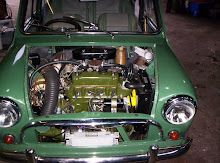A small alteration in the ignition timing—the instant at which the spark occurs in the combustion chamber—can have an appreciable effect on the performance and fuel consumption of the engine. Moreover the optimum timing at any moment depends on a number of factors which vary as
Fig. 39. Left, the manual timing adjustment. Right, after slackening the nut (1), the distributor body can be turned towards A to advance the timing or towards R to retard it
running conditions change. The grade of fuel that is normally used also enters into the picture, "premium" or "super" fuels being less liable to detonate or pre-ignite than "regular" brands when the engine is pulling hard at low speeds, thus allowing a greater degree of ignition advance to be used than would otherwise be the case.
Before dealing with timing adjustments, therefore, the action of the automatic controls incorporated in the distributor must be briefly described. If these are not operating correctly the performance of the engine will be completely upset. Although the fact is seldom stressed in instruction books, the time spent on a thorough distributor check-over on one of the modern motor-driven test sets that are to be found in larger garages is seldom wasted.


0 comments:
Post a Comment